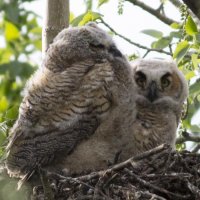9VIII said:
National Geographic would print whatever they can get as long as there’s no alternative, this just isn’t a “full page spread”, but at a quarter page no-one would be able to tell the difference, and the shots that are in focus still aren’t sharp enough to change that.
I didn’t use the sharpest image in the batch, but the response from this forum wouldn’t have been any different if I had.
This is a forum of gear junkies and that’s how the game is played.
The first examples I gave aren’t even half as detailed as the “OOF” image and yet Tron could hardly believe anything as lowly as the 1300D, let alone the 1100D, was capable of anything like these kinds of results.
We're talking about the same photos, right? The ones from this series:
9VIII said:
Here’s some better samples.

Yes, the Canon T3 (1100D) shoots BIF.
Now, please, indulge me. I'm going to try to be critical as a fellow birder; please don't take what I say personally. It isn't meant as an attack on you.
1. I think that your JPEG is an unflattering rendering of the RAW. Using your CR2 (your link and password you posted), I recropped 700x700 pixels, and it looks SIGNIFICANTLY sharper. With your permission, I'd be happy to post it.
2. Based on the re-crop 1:1, I believe that you're right: a lot of casual folks would happily accept "the subjects" as being in-focus.
But there is a major caveat, #3.
3. When judging focus on birds, the criteria for being in-focus is usually that at least one eye is perfectly in focus. I think that critical focus is achieved on the tailfeathers of the nearest owlet, whose head is tucked in. The second owlet, is slightly, but detectably, out of focus. It's perfectly fine to argue that at f/5.6, both of them can't be in focus at the same time. But being critical, it's much more important to for the owlet that's looking at you to be in focus than the one that's turned away; this is why it looks out of focus, in my opinion (the eyes are slightly soft).
Aside from the issue of focus -- Now, I'm being critical, but not trying to diminish the great moment that you caught, not trying to make this a personal attack or be a jackass. I apologize about the NG comment, as it was more flip than I intended. I'm happy that you got this great shot, and I would have been excited to get it too. However, I do NOT think that this is an amazing photograph, for the following reasons:
4. Most importantly, because it's missing a critical element - light. The sun is behind the owlets, casting a shadow on the subject facing you. You can't get an amazing photo of birds this way, whether you have a 30 year old film camera or a 1DXII, whether you're using a free kit lens or a 600DOII on a tripod. Since you can't go to the other side of the nest (leaves obstruct view) the only two solutions are to come back and shoot it at a different time of day, or to try to improve the shot with a flash or strobe.
5. Secondly, the photo does not achieve great composition, because you have two potential subjects that are competing for attention. The near owlet is actually in a pretty interesting pose, and where it by itself, that would make for an interesting moment. But because the second, further, smaller subject is engaged with the camera and its head is brighter, it draws more attention. But it's partly obscured, not in a particularly storytelling way, and (in my opinion) slightly out of focus.
In my opinion, it is the sort of situation where if you're very patient, and come when the light is right, and get lucky, you might capture an AMAZING moment.
I think that there's nothing at all wrong the T3, taking the shot, as the T3 takes perfectly fine shots at ISO 400. I do think that the focal length of the lens is too short, because the resulting photograph is only about half a megapixel (around 750x750), if you crop out the framing leaves.
I cannot speak for other people, but broadly speaking, even though I really like camera gear, I truly do not think that it's necessary to have a super fancy camera body to take amazing photography of birds or anything else. I have some razor sharp, amazing photos taking from my oldest Canon digital camera, a t2i.
Since you were talking about birds in flight, I do think that at a minimum a camera needs to be able to take at least 1/2000, or preferably 1/2500 shutter speeds to reliably sharp BIFs, especially if they're faster moving. You don't need a long telephoto lens, but it certainly helps. But if you do, then a full frame camera can probably really help the slower aperture, especially if you don't have enough light. Hence, why birding can get so damned expensive.
But you don't
need it. I took perfectly good songbird and hummingbird photos -- where I started birding -- with a t2i and a kit lens, and would be happy to share some of them to make that point, but I don't want to dilute this post.


